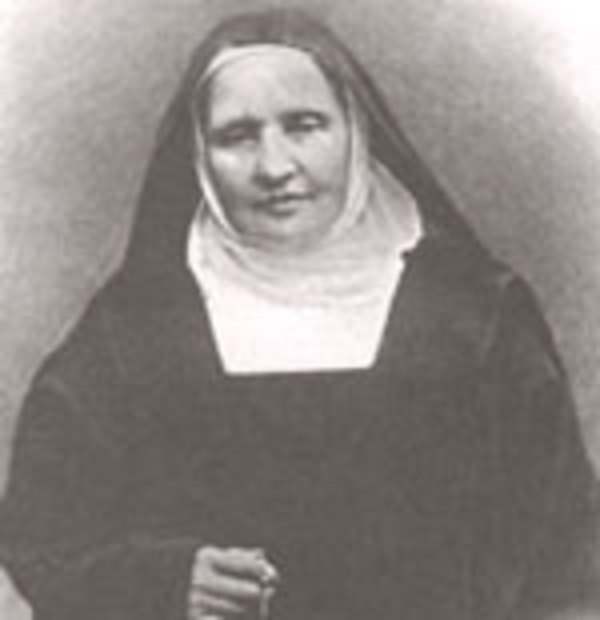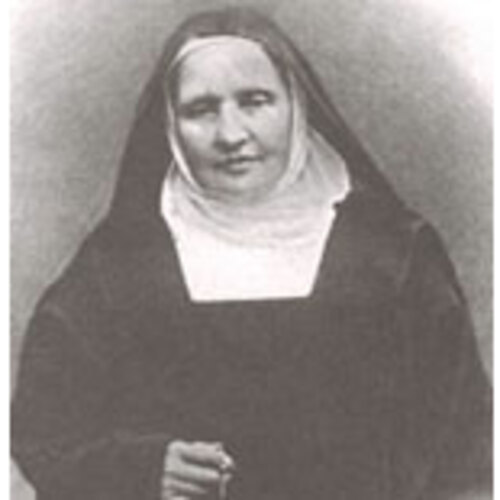
Source: Link
HÉBERT DE LA ROUSSELIÈRE, MARIE, named Marie-Clémentine de Jésus-Hostie (at birth she was given the names Henriette-Anne-Florence-Marie), promoter of Eucharistic works; b. 12 May 1840 in Angers, France, daughter of Alfred-Augustin Hébert de La Rousselière and Marie-Clémentine Bodin des Plantes (Desplantes); d. 3 Oct. 1924 at the Carmelite monastery in Angers.
Marie Hébert de La Rousselière was descended from a distinguished family of magistrates and notaries. When she was still very young, she and her sister Clémentine were given into the care of their maternal grandmother. Her life would be closely linked to that of her sister. In 1865, when Clémentine left to live in Paris after her marriage to André Brisset des Nos, she accompanied the young couple.
At the Sanctuaire de l’Adoration on Rue Faubourg Saint-Jacques, Marie was fascinated by the preaching of Father Pierre-Julien Eymard, the founder of the Blessed Sacrament Fathers; this congregation was dedicated to glorifying Christ in the Eucharist by adoration of the Blessed Sacrament and discipleship. She recognized him as a perceptive confessor. In October 1879 she resolved “to organize a sort of chain of worshippers, consisting entirely of priests, wholly dedicated to the glory of Jesus the Sacrificial Victim.” The plan was favourably received by the priests. In January 1881 the work, which had been taken over by the Blessed Sacrament Fathers, was approved by Pope Leo XIII under the name of the Association des Prêtres Adorateurs.
That year Marie found in Canada, in Father Cyrille Beaudry*, an enthusiastic promoter who in 1883 would become the North American director of the association. By 1913 it would be a worldwide body with 120,000 members. She also came into contact with the faithful from French parishes through the Œuvre de l’Exposition Mensuelle du Saint Sacrement and gave assistance to poor parishes through the Œuvre des Tirelires Eucharistiques. A tireless champion, she was in charge of the Bureau des Œuvres Eucharistiques in Paris.
Marie had come to know Father Beaudry through Brother Eugène Prévost*, who had joined the Blessed Sacrament Fathers in Brussels in 1881. A native of Saint-Jérome, Que., Prévost was a friend of the curé François-Xavier-Antoine Labelle*. The two men had dreamed since 1881 of establishing a community of Blessed Sacrament Fathers in Canada, and with the support of Fathers Edmond Tenaillon and Louis Estévenon the project took shape. In the spring of 1885 and with the backing of Labelle, Marie boldly and persistently urged Bishop Édouard-Charles Fabre* of Montreal to build a large chapel in his city for the community. Fabre insisted that this was no time for such a move. The diocese was in a precarious financial state and there were already enough male congregations. His refusal was categorical.
Marie came to Montreal in June 1886 with the Brisset des Nos family, who had decided to leave France because of the anticlericalism rampant there. For years she had been helping her sister Clémentine, whose health was frail, with the education of her children. She was fairly well off financially, since she and her sister had inherited their grandmother’s chateau and had sold it two years before their departure. She was soon in Bishop Fabre’s good graces. In this land where the tradition of the Eucharist had endured from the earliest days of settlement, she too organized a service of adoration in the parishes and communities. She launched the Œuvre de la Journée Réparatrice du Premier Vendredi and published many booklets and pamphlets on spiritual matters. In March 1890, feeling the time was ripe, she urged Father Albert Tesnières, the superior general of the Congregation of the Blessed Sacrament, and Father Prévost to hasten to Montreal and set up there a sanctuary for adoration. Fabre welcomed them, and on 1 July he personally displayed the Blessed Sacrament in the house purchased through the generosity of Marie and the family of Father Eugène Seers*. This event marked the introduction of the congregation into Canada.
Marie’s fascination with atonement inspired her to build a chapel on the property of the Brisset des Nos family in Pointe-aux-Trembles (Montreal), and it was inaugurated on 25 May 1897. She asked Archbishop Paul Bruchési* to have it served by Dominicans, out of consideration for a nephew who had joined that community. In 1900 it was entrusted to the Blessed Sacrament Fathers. In 1913 Bruchési was to designate it a site of Eucharistic pilgrimage and in 1918 he would declare it an “accredited temple of atonement to the Sacred Heart.” It has been served by the Capuchins since 1921. Ever attentive to works of atoning adoration and prayer for priests, Marie gave her unconditional support to the work of Abbé Alexis-Louis Mangin, who with Éléonore Potvin had founded the Servantes de Jésus-Marie at Masson (Masson-Angers) in 1895.
After the death of her sister Clémentine in December 1900, Marie Hébert de La Rousselière returned to France. In 1902 she took the veil of the Carmelites in Angers, with the name of Marie-Clémentine de Jésus-Hostie. She died in 1924 at the age of 84, leaving works that still bear witness to her influence on the spiritual life of Canadians.
Marie Hébert de La Rousselière is the author of Histoire du pèlerinage La Réparation au Sacré-Cœur; un écrit posthume, P.-M. Hébert, édit. (Montréal, [1979?]).
Arch. de la Chancellerie de l’Archevêché de Montréal, RLF (Reg. des lettres de Mgr Fabre), 6: 43, 74, 86, 95, 104, 106, 168–69; 421.154 (dossier Antoine Labelle); 465.108 (Congrégation du Très-Saint-Sacrement), 885-1, 890-1. Arch. de la Congrégation du Très-Saint-Sacrement (Montréal), D-1, Fondation de Montréal; E-XV, Marie de La Rousselière; E-XVI, La Réparation; Aimé Côté, “Le Montréal des premiers jours,” dans “Le livre du famille” (texte dactylographié, juin 1951). “Association des prêtres adorateurs, revue et approuvée par S. S. Léon XIII, le 25 janvier 1881,” Le Très Saint Sacrement (Paris), 6 (1881–82): 464–67. Adrien Bergeron, “Mademoiselle de la Rousselière,” Le Sauveur (Montréal), 59 (juillet–août 1985): 7–8 to 61 (novembre–décembre 1987): 16–17. Léo Boismenu, “Mademoiselle de la Rousselière, en religion sœur Marie-Clémentine, du Carmel d’Angers (1838–1924),” Annales des Prêtres-Adorateurs et de la Ligue sacerdotale de la communion (Montréal), 27 (1924): 337–45. “Chronique et correspondance de l’Association des prêtres adorateurs,” Le Très Saint Sacrement, 7 (1882–83): 445, 640, 643; 8 (1883–84): 150. André Guitton, Pierre-Julien Eymard, 1811–1868; apôtre de l’eucharistie (Paris et Montréal, 1992), 302–3. P.-M. Hébert, “La famille Brisset des Nos, de Dreux (Normandie) à Montréal,” SGCF, Mémoires, 28 (1997): 243–59. Marie [Hébert] de La Rousselière, Histoire du pèlerinage La Réparation au Sacré-Cœur; un écrit posthume, P.-M. Hébert, édit. (Montréal, [1979?]). Guy Laperrière, Les congrégations religieuses: de la France au Québec, 1880–1914 (2v. parus, Sainte-Foy, Qué., 1996– ), 1: 116–25. “Œuvre de l’exposition mensuelle,” Le Très Saint-Sacrement, 9 (1884–85): 830. Une apôtre de l’eucharistie et de la réparation: Mlle Marie de la Rousselière, en religion “sœur Marie-Clémentine de Jésus-Hostie” du Carmel d’Angers, 1840–1924 (Angers, France, 1925; 2e éd., revue et augmentée par P.-M. Hébert, Montréal, [1996]).
Cite This Article
Édouard Bussières, “HÉBERT DE LA ROUSSELIÈRE, MARIE (Henriette-Anne-Florence-Marie), named Marie-Clémentine de Jésus-Hostie,” in Dictionary of Canadian Biography, vol. 15, University of Toronto/Université Laval, 2003–, accessed January 1, 2026, https://www.biographi.ca/en/bio/hebert_de_la_rousseliere_marie_15E.html.
The citation above shows the format for footnotes and endnotes according to the Chicago manual of style (16th edition). Information to be used in other citation formats:
| Permalink: | https://www.biographi.ca/en/bio/hebert_de_la_rousseliere_marie_15E.html |
| Author of Article: | Édouard Bussières |
| Title of Article: | HÉBERT DE LA ROUSSELIÈRE, MARIE (Henriette-Anne-Florence-Marie), named Marie-Clémentine de Jésus-Hostie |
| Publication Name: | Dictionary of Canadian Biography, vol. 15 |
| Publisher: | University of Toronto/Université Laval |
| Year of publication: | 2005 |
| Year of revision: | 2005 |
| Access Date: | January 1, 2026 |



